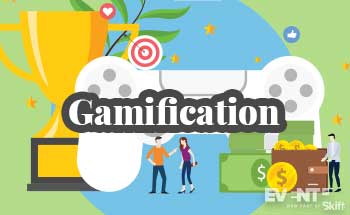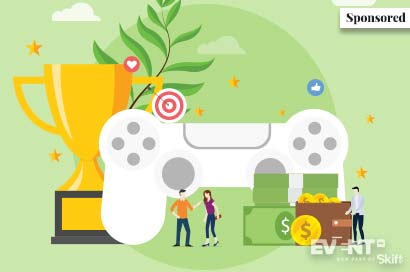

Gamification is big. And it’s not only in the events industry—gamification has a major presence in any field where motivation and engagement is a factor of success.
It’s about more than just playing games. Applying game design concepts—like points, competition, and awards—to non-game contexts is proven to create psychological satisfaction and meaningfulness in tasks. Certain elements of game design help players create narratives as well as experiences of social relatedness.
From an event planner’s perspective, gamification simply encourages people to do things in exchange for rewards. It might be a physical prize, emotional satisfaction, or community building.
At events, planners have taken advantage of gamification to design robust experiences that encourage attendees to engage with sessions, discussions, and exhibitors. By using the right game design, it’s possible to direct gamification towards meeting any number of event goals.
That said, how do you know if gamification is right for your particular event?
Basic Requirements of Gamification
Before you decide to go through with gamification, it’s important to define what sort of expectations you have of the particular event. An event that is suitable for gamification is one where you are interested in understanding engagement, and improving attendee participation and activity in the pursuit of event goals.
Gamification is also typically done through an event app, or other dedicated mobile technology. While offline gamification is definitely possible, it is infinitely more difficult to track activity and award points.
At a more bare bones event where the primary intent of the event technology is to provide information (such as speaker and attendee lists, scheduling, and session check-in) gamification is likely ill suited. Gamification for gamification’s sake is definitely possible—however, you may find that your efforts yield more results when it is used to uncover deeper analytics, gauge progress towards goals, drive more engagement, and encourage specific behavior from attendees.
When simply put, an event suited for gamification is one where you’re interested in how attendees engage with your event. An event app is the easiest way to integrate gamification into your existing event technology, though of course alternatives are available.
Gamification will work if: Your event is interested in how attendees engage and interact.
The Demographics of Gamers


A snap judgment might say that gamification is suited towards a younger crowd—millennials, maybe, or the quickly upcoming Gen Z.
However, the actual statistics of gaming challenges this assumption. The average age of people who play video games is 35, with just under half of all gamers between 18 and 49 years old. That means that the other half is under 18 or over 49. Even the gender divide is close to a 50/50 split at 59% male and 41% female. There’s no real stopgap age or gender demographic for people who play games.
Which means that when considering possible gamification, the demographics of your audience matter less than one would assume.
Because everyone plays games at some point or another, it’s much more prudent for an event planner to focus on the game design. Planners can create the ideal gaming circumstances for each particular attendee demographic. Instead of asking “Will my attendees play games?”, ask “Why will my attendees play this game?”
Every demographic—and in fact each group of attendees regardless of demographic—has different reasons for wanting to play.
Another aspect of motivation is reward. Gamification is more likely to succeed when the creator sets up reward circumstances suitable for the group of players.
So when setting up the gamification for your event, consider what type of reward will most cater to that particular demographic. Is it physical prizes? More vacation time? Recognition from their peers, opportunities to network with speakers, or other intangible rewards?
Gamification will work if: You know what will motivate your attendees to play the game.
Achieving Influence on Attendee Behavior
In many ways, gamification is like a loyalty program.
Because each action that an attendee performs holds a chance of rewarding them – with points, and potentially prizes – gamification makes it more likely for attendees to keep doing rewarding actions.
So with gamification, an important aspect for planners is to make sure they understand exactly what should be gamified—what do they want to encourage attendees to do?
Reg Kao, gamification expert, explains this metaphor as inventory turns at a grocery store. With that type of loyalty program, people get more points for buying certain items, so they tend to buy those items more often. With gamification, it follows that if you want to increase the number of interactions between attendees and exhibitors, you need to gamify the exhibitor part of the app. The game encourages attendees to spend more time in that part of the app, and with exhibitors.
With some creativity and flexible event technology, gamification can be effective for all types of event goals. This might be increasing networking activity between attendees, driving more interaction with content, or even improving levels of happiness.
For example, when the IRF wanted to incorporate the ‘happiness’ theme into their attendees’ experiences, they designed the game to help players identify and highlight positive experiences throughout the event. This included several elements, but the primary mechanism of the game was awarding points in exchange for particular actions. Attendees were encouraged to share photos of their ‘happy place’ at the venue; send encouraging or complimentary messages to other participants in-app; and write down daily notes that outlined what they had appreciated that day, among other tasks.
Gamification will work if: You’re interested in influencing attendee behaviors to achieve event goals.
A Need for Analytics and Improvement


An added benefit of gamification is how it allows you to track and adjust for attendee behavior.
While most event apps are able to provide analytics on how attendees are engaging generally—most viewed/downloaded documents, most popular sessions and topics, app adoption rate—gamifying aspects of your event allows the planner to get more comprehensive insight into how the event is progressing towards objectives.
By nature, gamification highlights certain aspects of your event and event content, and encourages attendees to interact with them. Because of this, the statistics of your game is able to provide insight into whether attendees are behaving in desired ways, to reach the event goals, while the event is ongoing.
This provides valuable flexibility. In order to achieve the event goal, event planners need to be able to get the information they need to adapt their tactics to the way that attendees are seen to be responding. Because gamification shows very specific statistics of behavior, it’s possible to change the game to match the flow of the event, or utilize other ways to drive attendees towards the set objectives over the course of the event. Each click and view is captured, so it becomes possible to track how attendees are reacting to each aspect of the event or game, and adjust them to optimize for more, or more valuable, interactions.
In addition, showing improvement year over year at an event can be difficult—and difficult to achieve. Through gamification, it’s possible to create and measure realistic, achievable, and quantifiable goals.
Gamification will work if: You want analytics to prove the value of your event and make adjustments to improve.
Creating Value in Specific Interactions
Monetization of event apps works a bit differently than typical monetization of apps. Attendees are not expected to pay to access certain functions of an event app—that would make for a very poor experience!
Instead, event app monetization often occurs from sponsors and exhibitors. This creates an additional consideration for planners to create and prove ROI for those sponsors. Gamification adds value by providing higher visibility to sponsors via the game, helping to drive more traffic and interaction towards exhibitors.
If, for example, your game is set up to improve attendee and exhibitor interaction, the analytics will show you what type of interaction was most common during the course of the day. Based on those analytics, a planner can adjust the game overnight, and give more focus on day 2 on exhibitors who didn’t get a lot of attendee face time. On an additional day, attendees can highlight platinum sponsors, and so forth.
The gamification report can be very valuable to exhibitors as well. The app is a great way to monitor the event and see actual results as they come in – perfect for exhibitors who need to justify their investment, and a good way for planners to understand and then prove the value of sponsorship.
Gamification will work if: You’re looking for additional ways to provide and prove value to exhibitors and sponsors.
Effective Learning with Gamification


Games for learning have become more popular in recent years. Educational apps have played a big part in that growth. Duolingo, for example, is a popular language-learning app that pairs short lessons with daily challenges, a points and levels system, and performance-based awards.
Although it may seem contradictory, many different educational fields have seen success by using gamification to aid in learning. The goal is to help students maximize enjoyment by utilizing game elements in learning environments. This essentially makes education more hands-on, inspires them to continue learning, helps information retention, and encourages students to voluntarily revisit lessons.
For any event where it’s important for attendees to take away some knowledge or learning, gamification is an excellent way to incorporate education in the attendee’s experience without overloading the user with information—and to make sure that they’re leaving with the information that they need.
Incorporating skill testing questions is a great way to gamify education or training events. Like other education apps, players can gain points for answering questions corrects and trying tests again. At an event, you can also award points for downloading documents, or exploring different parts of the app.
Adding an element of competition and motivation via a points system, and even an in-app scoreboard, can go a long way in making attendees more inclined to engage in learning activities. Training events can beneficial, but educational gamification can be incorporated into any event where learning is an event goal.
Gamification will work if: Your event is involved in learning, education, or training.
Resource Requirements of Gamification
While gamification has many benefits, and can help planners reach goals and provide analytics, it’s important to recognize that building game elements into your event will take time and resources.
An event app is typically an integral part of gamification—however, it will also take time and consultation with your technology manager to design and then create a game that encapsulates the event goal. Gamification is most efficient when it is built with the event’s strategy in mind. What types of engagement are the best indicators of goal fulfillment, how will they be measured, and what types of numbers will indicate goal success?
And while the existence of these goals, as they exist around improving engagement, proving ROI, measuring activity, and influencing behavior, is a crucial prerequisite to having gamification at your event, it is equally important that the planner can spend some time on the development of a game and event strategy.
If your event is coming up quickly, it may be more prudent to take in the analytics from the event app, and use them to help inform how you set up gamification the next time around.
Gamification will work if: You have the resources to spend time developing a viable game strategy for your event.
IN CONCLUSION
There’s been a lot of research around gamification. In our experience, it can help motivate attendees to participate, inspire interaction between attendees, exhibitors, and speakers, and help planners meet goals for the event—almost any type of event goal, so long as the game is properly designed and angled towards those objectives.
When it comes time to evaluate whether gamification is right for your event, or if you’re in the beginning stages of researching how to implement it, keep in mind that gamification helps to create an ongoing relationship between your event and your attendees. The event that is best suited to gamification is one where you’re interested in learning more about how attendees interact with content, sessions, and each other, and where you want to influence that behavior towards event goals.
At its best, gamification helps exhibitors create relationships with attendees, helps attendees interact meaningfully with your event, improves audience retention, and provides a method through which planners can implement, test, and optimize ways to engage with their audiences.






